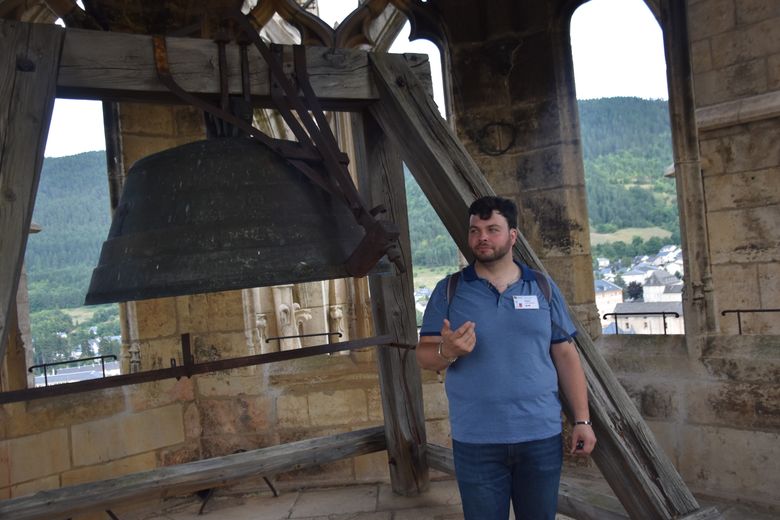Guided tour of the cathedral bell tower all summer long: Mende legends told and sumptuous views guaranteed

The large bell tower of Mende Cathedral can be visited all summer long. Midi Libre – Corentin Migoule
The guided tour of the bell tower – sometimes combined with that of the Notre-Dame-et-Saint-Privat Cathedral of Mende – is an unmissable summer event in the prefecture city. Tourists and locals alike enjoy the stories told there and the viewpoints perched 84 meters high.
Consecrated in 1467, almost a century after its construction began in 1368, the Notre-Dame and Saint-Privat Cathedral is a source of pride for Mende that the tourist office does not fail to highlight through guided tours throughout the summer. The same goes for its tallest bell tower, perched 84 metres high, which is revealed several times a week under the guidance of tour guide Géraud Boyer.
Exceptional measurements
We took part in one of these visits this Tuesday, August 6, 2024, in the company of four participants previously registered with the tourist office. They first discovered the remains of what was once the largest bell in Christianity, cleverly named the “Non-Pareille”. Cast and installed in 1517, it was distinguished by its exceptional measurements: 2.75 m high; 3.25 m in diameter; 33 cm thick, for a weight of around 13 tons.

Géraud Boyer punctuates his guided tours with anecdotes. Midi Libre – Corentin Migoule
On the days of major feasts in the liturgical calendar, “it could be heard ringing as far as Chanac in favourable winds”, recalls Géraud Boyer. Unfortunately, it did not resonate for long. In the second half of the 16th century, the Wars of Religion broke out and obviously did not spare Lozère, nor its prefecture, which was resolutely Catholic at the time.
The consequences of the Wars of Religion
“The Wars of Religion were absolutely tragic here. Many Protestants and many Catholics in the same place, inevitably sparks fly”, resituates the tour guide. Huguenot captain born in Uzès (Gard), Mathieu Merle spreads terror when he enters the service of the richest baron of Gévaudan. But the latter dies during the Saint-Barthélemy on August 24, 1572 and his lieutenant thirsts for revenge.
“Mathieu Merle thus began”a cycle of violence”, Géraud Boyer explains in a voice as gentle as his azure blue gaze. And to continue”: “He first attacked the Baron of Saint-Chély-d”Apcher. He then attacked Malzieu. He took Ambert, Issoire, and will fail to take Saint-Flour." Then comes the turn of the city of Mende, attacked by surprise one Christmas Eve 1579.
While the Catholics of Mende were at midnight mass and the bell rang loudly, thus covering the foreign noises, Mathieu Merle's troops entered the building, the destruction of which the latter would soon order. After which the Non-Pareille is melted down to recover the bronze that is used to build cannons and culverins.
241 steps to climb
Only the 460 kg clapper survives this episode and remains today to be discovered at the entrance to the large bell tower. “I like to make tourists believe that the object is used to stir aligot but the joke no longer works”, laughs the guide, who then announces to the participants the “terrible ascent” of the 241 steps leading to the main bell tower, which is now the third largest in Occitania behind that of Rodez (87 meters).

The Penitents Tower can be seen easily from the terrace. Midi Libre – Corentin Migoule
The visitors are out of breath climbing the steps and Géraud Boyer suggests a first stop at the terrace which already offers a very beautiful view of the Causse de Mende and that of Chantefège. The guide draws the audience's attention to the cathedral's roof made of slate slate, as well as to the visible Penitents' Tower on the horizon, one of the last vestiges of the ramparts of the city of Mende.
“This is the floor where the Non-Pareille was installed, even if some Mendois believe that it was at the very top”, the speaker specifies. Nearly 90 final steps "very irregular" then separate visitors from the highest point, which is finally reached at the end of a dizzying climb.
"A quarrel of egos"
At the top, the views of the Lozère prefecture are appreciated and immortalized with selfies and other photos. The asymmetry between the two bell towers is also obvious and invites us to question ourselves. Why such a difference in height between the largest (84 meters) and the smallest (65 meters) ? "Three hypotheses coexist and each Mendois is attached to one of the three", warns Géraud Boyer.
Although there are few official writings on this subject, the latter has his own, forged by a spirit of deduction and logical reasoning. “The most credible hypothesis is an ego quarrel between the bishop and his canons”, concludes the man who provides around 500 visits to the great bell tower each summer. To punish them symbolically, the bishop is said to have built a large and sumptuous bell tower on the side of the episcopal palace; a less ornate bell tower on the side of the canons' cloister.
Access to the bell tower is limited to 12 people and is prohibited to those under 10 years of age. Price: 5 euros for adults, 3 euros for children aged 10 to 18. Reservations are strongly recommended at the tourist office: 04 66 94 00 23 or contact@mendetourisme.fr The meeting point for the departure of the visits is at the tourist office, place du Foirail de Mende. I subscribe to read more




